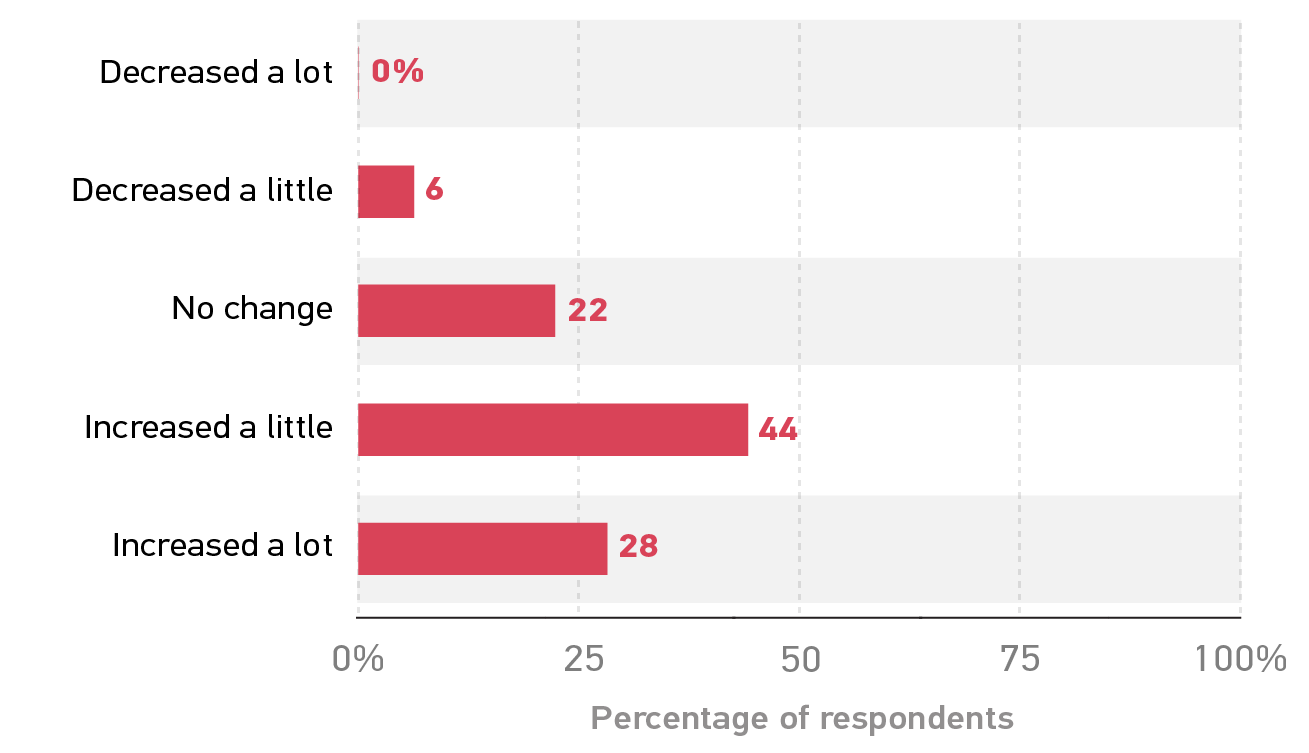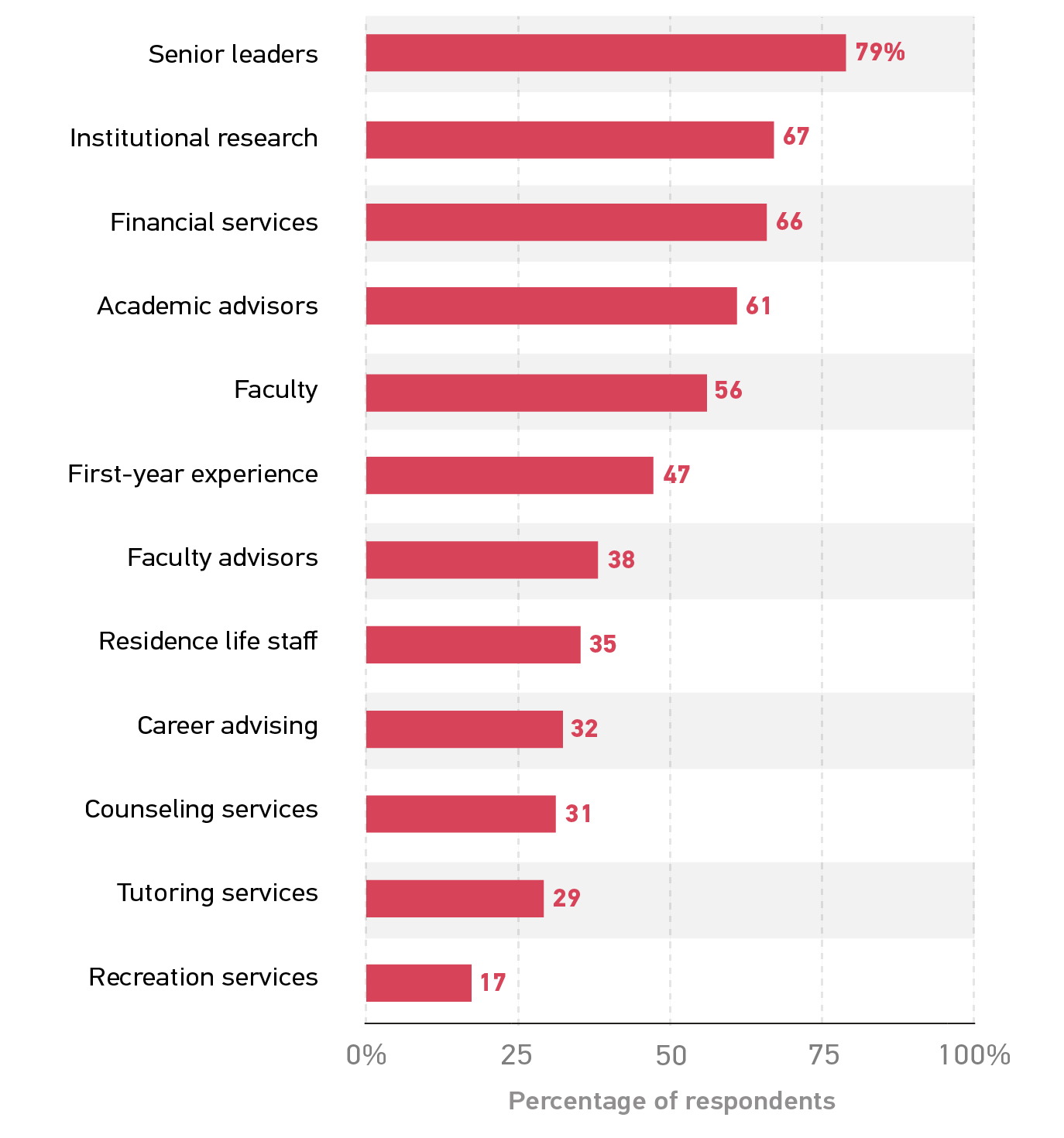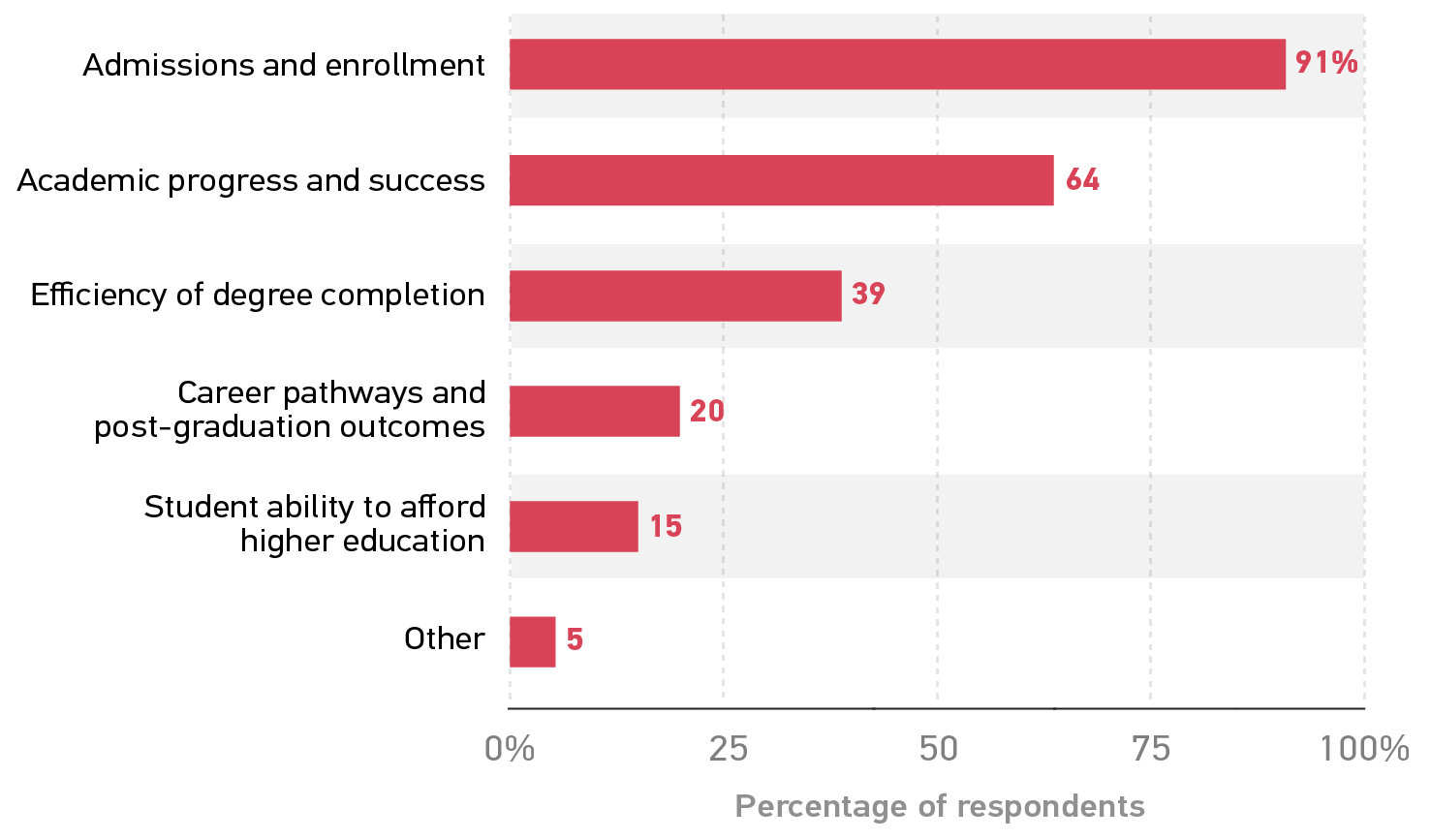The pandemic has prompted important changes in how higher education faculty and staff use—and budget for—technologies that can support student success.

EDUCAUSE is helping institutional leaders, IT professionals, and other staff address their pressing challenges by sharing existing data and gathering new data from the higher education community. This report is based on an EDUCAUSE QuickPoll. QuickPolls enable us to rapidly gather, analyze, and share input from our community about specific emerging topics.Footnote1
The Challenge
We have known for a while that a majority of students think that the student success tools provided by their institutions are very or extremely useful. And the importance of these technologies has likely only increased since the onset of the pandemic. The continued provision and support of student success technologies despite shrinking institutional and IT budgets may pose a significant challenge for many institutions in the post-pandemic era. Balancing priorities for meeting the operational and fiscal needs of the institution, meeting the needs of faculty and staff, and investing in the right tools to meet students' needs poses an additional challenge.Footnote2
The Bottom Line
Investment in student success technologies actually went up during the pandemic and is expected to increase in the next 12 months, particularly in areas geared toward developing technological efficiencies, supporting students, and identifying opportunities for cost savings. Key stakeholders are engaged frequently to track and support student success technologies, but there is room for more collaboration across the institution. Customer relationship management (CRM) platforms are emerging as an important student success technology in other stages of the student life cycle and have the potential to consolidate functionalities into a single platform.
The Data: Last Year's Spending
The pandemic has not adversely affected institutional investment in student success technologies. A majority of respondents reported that their institutions have increased their investment in student success technologies either a little (44%) or a lot (28%) in the past 12 months (see figure 1), a change that perhaps reflects a new awareness of the vulnerabilities that some students are experiencing as a result of the pandemic. No one reported large drops in spending on student success technologies.

The Data: Next Year's Spending
The categories of student success technologies most expected to see increased investment appear to be strategic with regard to developing technological efficiencies, supporting students, and identifying opportunities for cost savings (see table 1).
Table 1. Percentage of Respondents Expecting an Increase in Investment in Student Success Technology Categories in the Next 12 Months
| Student Success Technology Category | Percentage Expecting Increased Investment |
|---|---|
|
Customer relationship management (CRM) |
44% |
|
Alerts, signals, and notifications |
40% |
|
Chatbots |
40% |
|
Health and wellness |
37% |
|
Integration solutions |
34% |
|
Academic planning and audit |
31% |
|
Learning management system (LMS) |
31% |
|
Academic tutoring |
30% |
|
Performance measurement and management |
21% |
|
Aid and benefits |
20% |
|
Career planning |
17% |
|
Mentoring and life skills |
17% |
|
Caseload management |
16% |
|
Co-curricular recognition |
11% |
|
Transfer evaluation |
11% |
|
Implementation services |
7% |
|
None of these categories |
7% |
|
Diagnostics |
4% |
Increased investment in CRM platforms signals a change in how higher education is thinking about using this technology. CRMs have not typically been part of the suite of technologies identified as a student success technology, per se, but there may be new opportunities to leverage the capabilities of these systems to develop new tools or reduce redundancies in student success applications.
More spending on alerts, signals, and notifications is an investment in what works. Students who receive alerts or nudges act on them. However, the technology alone is not enough to produce long-term changes in the behavior triggering the alert or nudge. Herein lies an opportunity for partnerships between IT and academic support units to pool resources for a more robust model of support after the alert is received.
Investment in chatbots creates opportunities to efficiently support students. Chatbots programmed to address students' most frequently asked questions may save students time, effort, and frustration when seeking on-demand, important information. Chatbots may also free the individuals normally tasked with responding to first-level student queries about campus resources to spend more time actually providing those resources and helping students.
Expanding health and wellness technologies reflects efforts to support the whole student. The pandemic has increased awareness of the need to provide students with access to information about or resources to support health and wellness, especially mental health. The expected increase in investment in such technologies demonstrates a commitment to a more holistic approach to student success advocated by many in higher education.
The Data: Student Success Partners
It takes a village to support student success (technologies). As the importance and scope of student success technologies have increased, the need to cultivate deeper and enduring partnerships with key stakeholders across the institution has intensified. For each of the 12 institutional stakeholders about which we asked, a majority of respondents reported partnering at least sometimes to track and support student success technologies. Among the most critical and frequently engaged partners are a mix of the usual suspects: senior leaders (79% partner with often or always), institutional research (67%), financial services (66%), academic advisors (61%), and faculty (56%) (see figure 2). Given that the pandemic has accelerated the demand for a more holistic approach to student success, some of the less frequently engaged partners—especially residence life staff (35% partner with often or always), counseling services (31%), and tutoring services (29%)—might become more critical as students return to campus.

The Data: The CRMs Are Coming
CRMs are widely used to manage student data. CRM technologies are used extensively in higher education but are not typically used to collect, integrate, and use data collected from student systems.Footnote3 Nearly two-thirds of respondents (62%) reported that their institutions are currently deploying a CRM system to manage student data (see figure 3).

CRMs are staking a claim as a student success technology. For those who have a CRM, admissions and enrollment (91%) is—not surprisingly—the primary stage in the student life cycle that is tracked and/or supported by the technology (see figure 4). But substantial numbers of respondents also report that CRMs are now being used to track and/or support academic progress and success (64%) and efficiency of degree completion (39%), tasks for which stand-alone student success applications have previously been deployed. CRMs have a way to go before they evenly and comprehensively track and/or support the student life cycle from applications through alumni status.

Common Challenges
Meet the new challenges, same as the old challenges. Four main types of challenges are prominent, all familiar to IT and the domain of student success technologies: technology, data integration, resources, and buy-in/change management.
The technology challenges are related to the deployment of too many student success technologies:
- "We have too many products. Admissions likes one, advising and faculty like a different one, the registrar likes another one, etc.It's too hard and confusing for faculty, staff, and students."
- "Multiple CRMs are in use. One for admissions and another by advising/student success."
- "We have [multiple] colleges, and getting a single process in place is key to success. We also have some colleges with CRM and others without."
Data integration has been a problem since the introduction of student success technologies, one of many reasons why the "uses of APIs" has topped the EDUCAUSE Top 10 Strategic Technologies list in 2018, 2019, and 2020:
- "We have data distributed across decentralized units; we need better ways of integrating data from various CRM and other systems into a cohesive structure. We are challenged in coordinating all our infrastructure so we can take action from student success data."
The resource challenges are both human and financial. A dearth of financial resources undermines institutional ability to hire enough staff to handle the advising and counseling caseloads:
- "Restoring face-to-face encounters and counseling is a personal context with struggling students [is challenging]. It's one thing to understand things from the data; it's quite another to 'grasp' the entire person and then move to ways to work together to help out."
- "We need to expand the number of offices that students can set appointments with through the mobile app."
Getting end-user buy-in and facilitating change management is an evergreen challenge. Respondents told us that "adoption," "getting everyone to use [the tools]," "getting everyone on the same page," and "getting the word out" on the technologies continue to pose challenges to the successful adoption of student success technologies.
Promising Practices
One student success technology to rule them all? The one promising practice identified by respondents is the adoption of CRMs to take on various functions otherwise performed by specialized student success technologies. Frustration with having "too many tools" may be an impetus behind this consolidation, a practice that could reduce tool fatigue on students, faculty, and staff and reduce overall costs for the institution:
- "We expect to implement a student-focused CRM this next year."
- "We actually just began a project to do this with the expectation that it will be available later this year for all student services areas of the college."
- "We are implementing the student success/retention CRM now."
- "We have [a commercial CRM] for admissions, and we are expanding it to include advising and case management for about 20 offices. This will also include chatbot."
- "We expect to migrate our homegrown tools for communication, service delivery, and case management to [a vendor solution] over the next few years."
All QuickPoll results can be found on the EDUCAUSE QuickPolls web page. For more information and analysis about higher education IT research and data, please visit the EDUCAUSE Review EDUCAUSE Research Notes topic channel, as well as the EDUCAUSE Research web page.
Notes
- QuickPolls are less formal than EDUCAUSE survey research. They gather data in a single day instead of over several weeks, are distributed by EDUCAUSE staff to relevant EDUCAUSE Community Groups rather than via our enterprise survey infrastructure, and do not enable us to associate responses with specific institutions. Jump back to footnote 1 in the text.
- The poll was conducted on April 5–6, 2021, consisted of 11 questions, and resulted in 134 responses. Poll invitations were sent to participants in EDUCAUSE community groups focused on IT leadership and teaching and learning. Our sample represents a range of institution types and FTE sizes, and most respondents (97%) represented US institutions. Jump back to footnote 2 in the text.
- According to the 2018 report Institutions' Use of Data and Analytics for Student Success: Results from a National Landscape Analysis, only 7% of respondents said that their institutions were systematically collecting, integrating, and using data collected from student systems. Jump back to footnote 3 in the text.
D. Christopher Brooks is Director of Research at EDUCAUSE.
© 2021 D. Christopher Brooks. The text of this work is licensed under a Creative Commons BY-NC-ND 4.0 International License.
